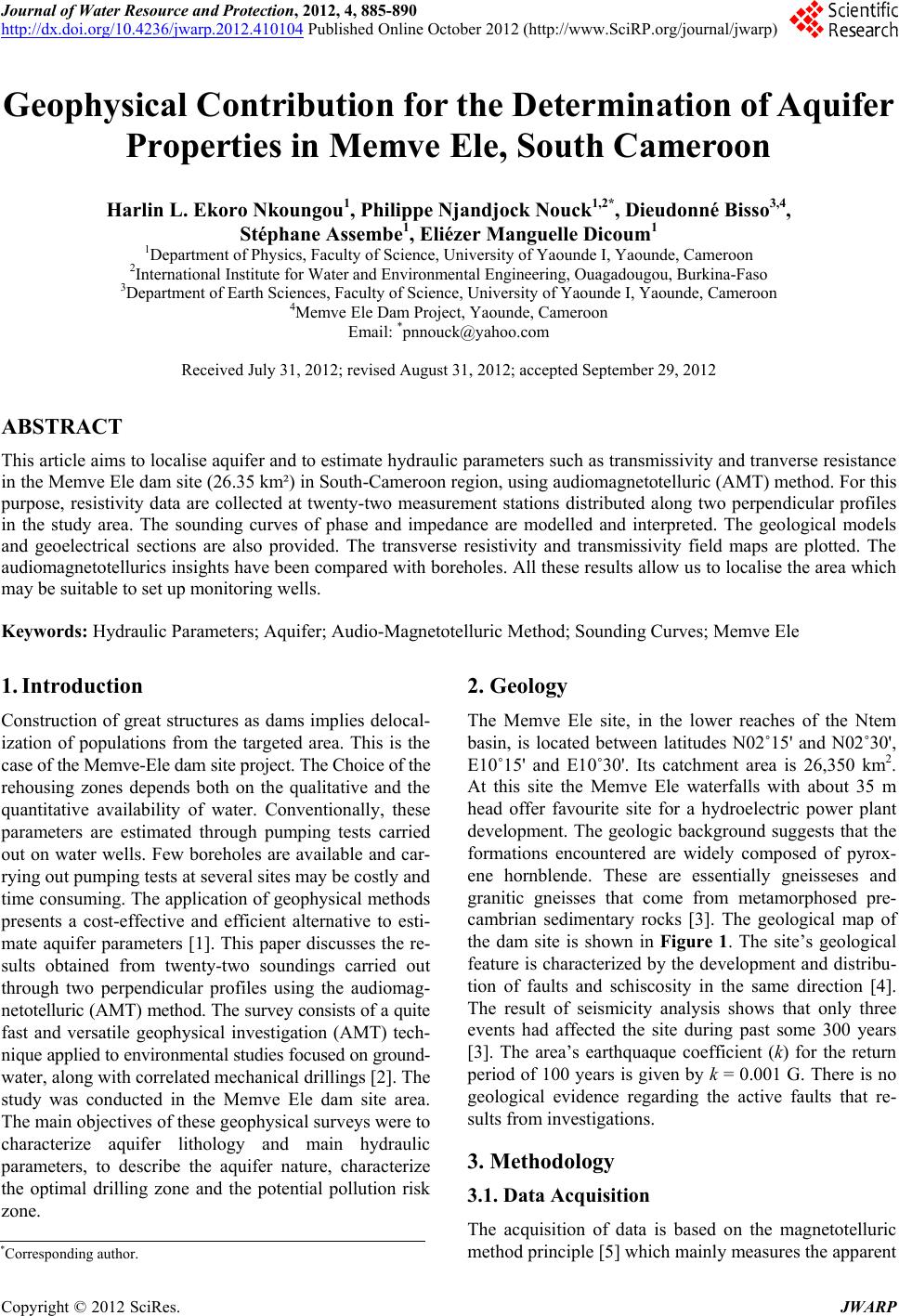
Journal of Water Resource and Protection, 2012, 4, 885-890
http://dx.doi.org/10.4236/jwarp.2012.410104 Published Online October 2012 (http://www.SciRP.org/journal/jwarp)
Geophysical Contribution for the Determination of Aquifer
Properties in Memve Ele, South Cameroon
Harlin L. Ekoro Nkoungou1, Philippe Njandjock Nouck1,2*, Dieudonné Bisso3,4,
Stéphane Assembe1, Eliézer Manguelle Dicoum1
1Department of Physics, Faculty of Science, University of Yaounde I, Yaounde, Cameroon
2International Institute for Water and Environmental Engineering, Ouagadougou, Burkina-Faso
3Department of Earth Sciences, Faculty of Science, University of Yaounde I, Yaounde, Cameroon
4Memve Ele Dam Project, Yaounde, Cameroon
Email: *pnnouck@yahoo.com
Received July 31, 2012; revised August 31, 2012; accepted September 29, 2012
ABSTRACT
This article aims to localise aquifer and to estimate hydraulic parameters such as transmissivity and tranverse resistance
in the Memve Ele dam site (26.35 km²) in South-Cameroon region, using audiomagnetotelluric (AMT) method. For this
purpose, resistivity data are collected at twenty-two measurement stations distributed along two perpendicular profiles
in the study area. The sounding curves of phase and impedance are modelled and interpreted. The geological models
and geoelectrical sections are also provided. The transverse resistivity and transmissivity field maps are plotted. The
audiomagnetotellurics insights have been compared with boreholes. All these results allow us to localise the area which
may be suitable to set up monitoring wells.
Keywords: Hydraulic Parameters; Aquifer; Audio-Magnetotelluric Method; Sounding Curves; Memve Ele
1. Introduction
Construction of great structures as dams implies delocal-
ization of populations from the targeted area. This is the
case of the Memve-Ele dam site project. The Choice of the
rehousing zones depends both on the qualitative and the
quantitative availability of water. Conventionally, these
parameters are estimated through pumping tests carried
out on water wells. Few boreholes are available and car-
rying out pumping tests at several sites may be costly and
time consuming. The application of geophysical methods
presents a cost-effective and efficient alternative to esti-
mate aquifer parameters [1]. This paper discusses the re-
sults obtained from twenty-two soundings carried out
through two perpendicular profiles using the audiomag-
netotelluric (AMT) method. The survey consists of a quite
fast and versatile geophysical investigation (AMT) tech-
nique applied to environmental studies focused on ground-
water, along with correlated mechanical drillings [2]. The
study was conducted in the Memve Ele dam site area.
The main objectives of these geophysical surveys were to
characterize aquifer lithology and main hydraulic
parameters, to describe the aquifer nature, characterize
the optimal drilling zone and the potential pollution risk
zone.
2. Geology
The Memve Ele site, in the lower reaches of the Ntem
basin, is located between latitudes N02˚15' and N02˚30',
E10˚15' and E10˚30'. Its catchment area is 26,350 km2.
At this site the Memve Ele waterfalls with about 35 m
head offer favourite site for a hydroelectric power plant
development. The geologic background suggests that the
formations encountered are widely composed of pyrox-
ene hornblende. These are essentially gneisseses and
granitic gneisses that come from metamorphosed pre-
cambrian sedimentary rocks [3]. The geological map of
the dam site is shown in Figure 1. The site’s geological
feature is characterized by the development and distribu-
tion of faults and schiscosity in the same direction [4].
The result of seismicity analysis shows that only three
events had affected the site during past some 300 years
[3]. The area’s earthquaque coefficient (k) for the return
period of 100 years is given by k = 0.001 G. There is no
geological evidence regarding the active faults that re-
sults from investigations.
3. Methodology
3.1. Data Acquisition
The acquisition of data is based on the magnetotelluric
method principle [5] which mainly measures the apparent
*Corresponding author.
C
opyright © 2012 SciRes. JWARP